![]()
Today we are travelling into the large town of Oldham which is situated in the North West of England and roughly 7 miles east of Manchester.
Historically speaking, Oldham became a boomtown during the early days of the Industrial Revolution and was indeed one of the first ever industrialised towns that quickly grew to become one of the most important cotton and textile industries in England.
By the late 1800s, the entire landscape had changed and the once rolling landscapes had been replaced and dominated by the distinctive brick-built mills that had become a common sight in towns and villages in the North of England.
And, as in places such as Blackburn, Accrington and Burnley where we have already covered stories like the one we are discussing today; unemployment, poor living conditions and harsh working conditions for those lucky to be employed, contributed to high levels of crime.
Now crime is nothing new and it occurs in all forms every single day, but some crimes are truly horrific in their nature and the story of Joseph Mellor which takes us back to Wednesday, the 19th October 1892 is no different.

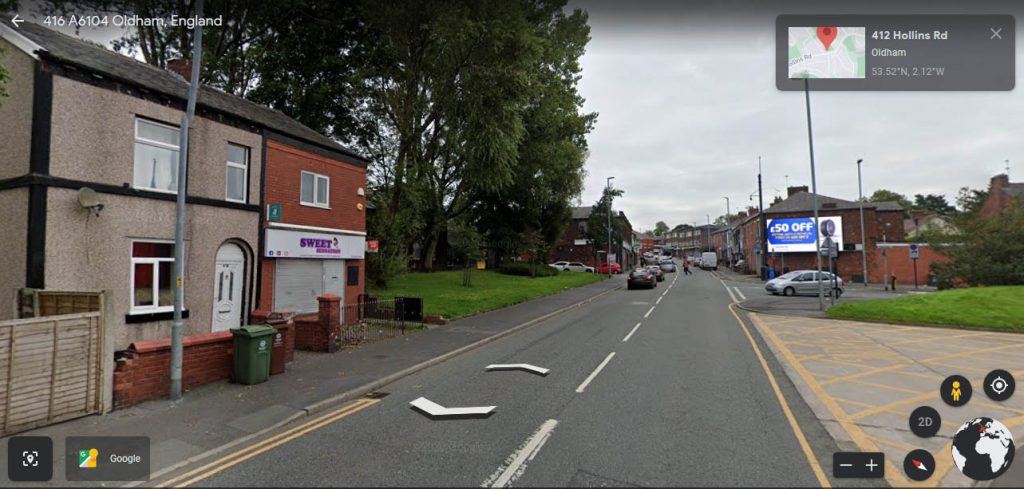
Hollins Road (2020) 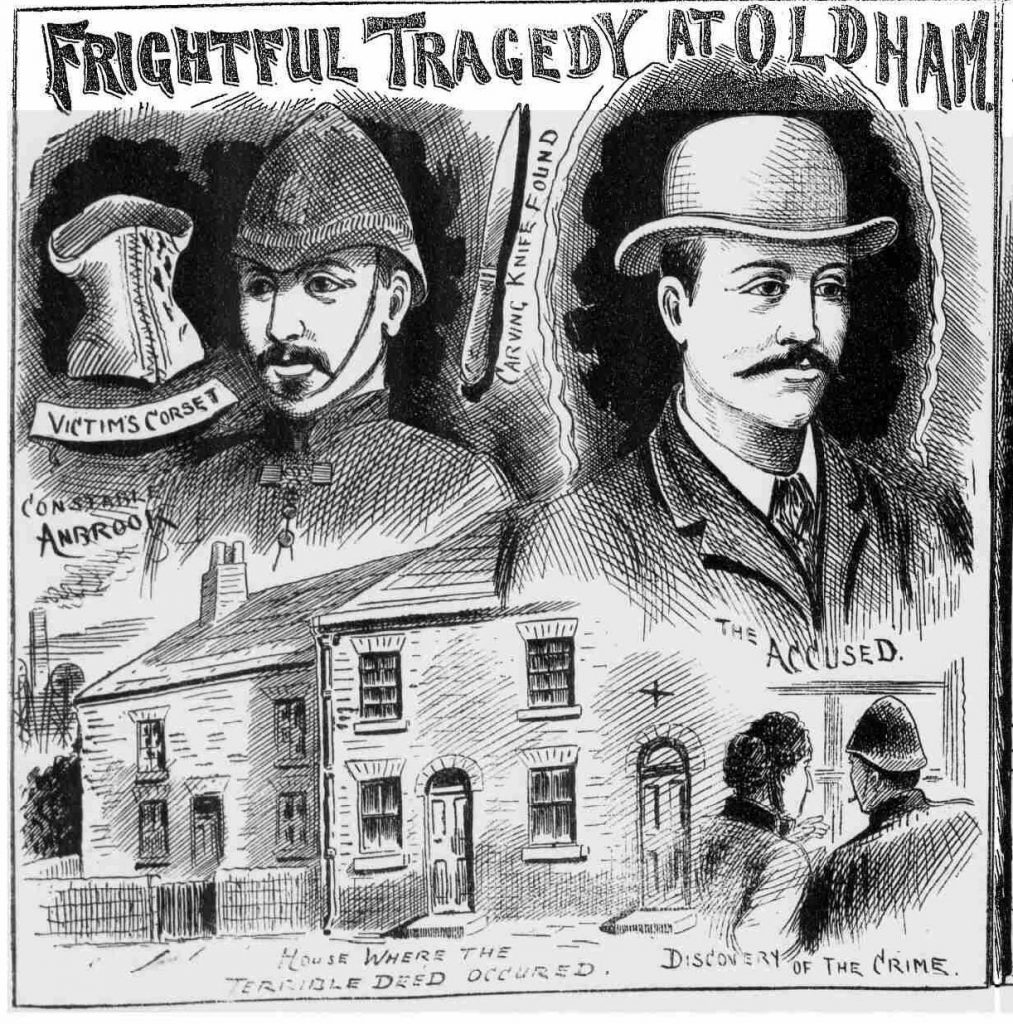
Hollins Road, back in the late 1800s was a relatively quiet neighborhood compared to many other areas of Oldham, and consisted of a row of houses that looked more like hamlets rather than the usual mill houses that had become a common theme during the Industrial Revolution.
At number 412, there lived 32 year old Joseph Mellor, along with his wife, Mary Jane who was aged 28, and it was reported that they had lived together at the property for the past five years.
It was shortly before 11am on the morning of the 19th October when Joseph was called into an office at his place of work over at nearby Melrose Mill. Upon entering the room, which was situated at the bottom of a set of stairs, Mellor was met by Police Constable Aubrook who asked him if Mellor was his surname. Nodding, PC Aubrook then asked; “I suppose you know what I’ve come for?” and removed a set of handcuffs before placing them onto the wrist of Joseph, whilst charging him with the willful murder of his wife. Surprisingly, Joseph seemed calm and not overly startled by the charge, replying; “Yes, all right”, and as he was escorted from the premises, one of his co-workers was overheard saying to him; “What’s up Joe?” to which Joseph replied; “Happen you’ll here.”
Outside, Joseph stopped and asked a manager if he could take one of the mill workers whom he knew with him to the police station for company to which his request was granted. Mellor and his companion, as well as PC Aubrook would soon make their way towards a cab that was situated a short distance away from the mill. On the way to the police station, Joseph stopped the cab and asked his companion if he would return back to the mill and to ask a girl whom he had been on friendly terms with if she would follow them to the police station.
After being placed inside a cell, it wasn’t too long thereafter that his companion, along with the girl Joseph had asked to bring back with him, would arrive at the station. Curious as to what was happening, the young girl would ask if she could talk to Joseph in his cell, but ultimately, permission would not be granted.
So what, you may be asking yourself, had Joseph done to find himself being arrested and locked up inside a police cell? Well, as already mentioned, the charge was murder – but who and why?
For these answers we need to go back an hour or so to 10.00am that morning and to Mary Walker, wife to Joseph Walker, landlord of Number 412 Hollins Road. She had called around to the home of Joseph and Mary, and after peering through a broken pane of glass in the window at the back of the house, she noticed that a large amount of soil had been dug up inside the kitchen. She quickly returned home and informed her husband, who then in turn called for Police Constable Aubrook who himself lived in the same neighborhood. As Walker and Aubrook made their way to number 412, they were joined by Waterman Booth, a friend of both men.
Upon entering the back garden, the three men soon made their way into the kitchen via the window and it was instantly obvious something was wrong as flag stones had been removed and large amounts of soil had indeed, as Mrs. Walker stated, been left piled up alongside a deep hole that roughly resembled that of a grave.
It didn’t take the men too long to find the reason behind a hole being dug inside the kitchen as the body of Mary Jane Mellor would soon be found, partly clothed, lying under the stairs and with a carpet thrown over her.
A fearful stench overcame the three of them as they recoiled from the sight of the poor woman under the stairs. Shocked by what they had found, Police Constable Aubrook went on to examine the house, finding a bloodied corset that had been cut through with a sharp knife.
As it was a relatively small neighborhood, Police Constable Aubrook knew exactly where to go to find Joseph Mellor and as he made to Melrose Mill, Chief Constable Robert Peacock was informed of the discovery of a body being found, and accompanied with Inspector Warburton, Detective-Sergeant Davies and Sergeant Lamb he made his way to the house to examine the scene in greater detail.
Inside, a large knife covered in blood was found on a shelf and a skirt and carpet were also discovered soaked in blood. An assistant working for Dr. Thomas Fort was called for and upon his arrival, the body of Mary Jane was removed from under the stairs and placed onto the floor next to where the flag stones had been lifted. Upon examining the body, it was apparent from the injuries sustained that the head was almost severed from the body and that there were at least half a dozen or more stab wounds made to the breast area.
The sight was horrific to say the least and the pungent smell of the rotting corpse was unbearable to the point that several police constables had to set fire to rags in order to nullify the odour. However, the smell was so bad that a barrel of disinfectant powder was sourced from a nearby chemist on Ashton Road, and scattered about the house. Now, some will say that this would surely compromise the crime scene, but you have to remember that DNA and fingerprint evidence as well as many of the scientific methods used in today’s policing were none existent back in the 1800s!
During the initial examination of the house, it seemed that it may have been vacant for a number of weeks, with a slight covering of dust on furniture as well as all of the windows. One newspaper reported that there was a dirty look and feel about and it looked as if no fire had been lit for some considerable time as the grate looked too tidy. However, there were pieces of carpet, cut into small squares and stacked close to the fire – seemingly with the intent of burning it to possibly hide any evidence once the body had been disposed of. Several letters that had been posted had been left lying on the floor behind the front door and small logs of wood were still in the fire grate, seemingly ready to be lit.
In fact, the only semblance of any recent human activity in the house was, of course, that of the ‘grave’ and the floor tiles and soil that were piled up in the kitchen, as well as traces of blood that was found on the floor of the ‘buttery’ under the stairs where Mary Jane’s body was found. And speaking of the buttery, a barrel of quicklime, opened, was found near to the bottom of the stairs.
The grave itself was around 3ft deep but large enough to admit a body and close by, Police Sergeant Davies came across a large kitchen knife, roughly 9″ long and stained with blood.
Mary Jane’s body, once the initial examination of the crime scene was complete, would be taken to the mortuary at Rhodes Bank where it would be examined in readiness for the inquest.
On Thursday, 20th October – Joseph Mellor was brought before the Oldham justices at the Town Hall where over 1,000 curious bystanders had crowded not only the room where the initial inquest would take place but also the steps leading into the building. The dense mass of people, all eager to hear the full and explicit details of the horrendous crime, despite threats from the police officers struggling to maintain order, tried to force their way into the Town Hall. Women fainted from the pressure of people forcing their way into the building and even the strongest of men were glad to escape from the suffocation of bodies. Police officers themselves where hemmed in and powerless to help.
Meanwhile, inside the hearing, Joseph had taken to the stand, wearing a dark clothed suit and white tie, his hair shortly cropped, he stood before the magistrates and was charged with the willful murder of Mary Jane Mellor.
After hearing the charges put towards him, Joseph replied; “That is not her name. It is Stafford, and I could tell you a lot more if I liked.”
Mr. Robert Peacock, Chief-Constable asked for Joseph to be remanded for a week so more evidence could be gathered to which Joseph replied saying he had no objections to the request.
The inquest on the body of Mary Jane Mellor would also take place on the same day before Mr. A. E. Smith, the Deputy Coroner.
In attendance was Annie Charlton, sister of Mary Jane and she would go on to give her evidence under great emotion, crying and sobbing the whole time. She would state that the last time she had seen her sister alive was sometime during April, and as she tried to explain in further detail, she exclaimed loudly, “He shouldn’t have done this, should he? He should have left her!”
Looking over towards Joseph, who had been asked to attend the inquest by the jury, Annie said; “That is her husband.” Joseph’s reply was strange; “One of ’em” he would say.
Next to take to the stand was Thomas Forts, surgeon and the man who performed the post-mortem on Mary Jane. His extremely detailed report on the body is as disturbing as the murder itself and goes on to state that she (Mary Jane Mellor) was 5ft 1in in length and well developed.
“There were no wounds on the arms, legs or abdomen, with the exception of an old wound. The body was much decomposed. The eyes were gone. There was in incised wound on the upper-lip, probably from some sharp instrument. Three teeth on the left side of the upper jaw had been knocked out. There were two wounds on the head, one immediately behind the left ear, one and a half inches in length, the other immediately at the back of the head. Corresponding with these wounds was a fracture of the skull extending from behind the left ear to the right ear. The brain was quite decomposed. The neck had a long incised wound in front, four inches in length, dividing the windpipe and all the other structures to the vertebrae. On the chest there were seven punctured wounds on the left side. Six of these passed through the ribs. The lungs were more or less decomposed.”
Dr, Thomas Forts
Forts could not say for definite how long Mary Jane had been dead for, owing to the cold weather and the fact that her body had been lying on a stone floor which had arrested decomposition to some extent. He would, however, say she may have been dead for a month or five weeks.
The inquest would be adjourned until the following week.
The adjourned inquest would take place on Monday, 24th October and it would be Emma Chadwick, wife of J.W.Chadwick, who would be one of the first witnesses to take to the stand.
Emma had known Joseph for much of her life and she remembered last seeing Mary Jane around the 3rd September. Two weeks later, she spoke with Joseph and asked how Mary Jane coping to which he replied; “All right.” She then asked how Mary Jane’s mother was doing and Joseph replied that she had had a stroke and he had travelled over to Hyde to see both the two of them. He also said that Mary Jane would be returning home soon. Emma had spoken to Joseph on another occasion when he had informed her that Mary Jane’s mother was paralyzed (presumably due to the stroke).
On the 3rd October, Joseph visited Emma, and in conversation he had told her that Mary Jane’s mother was getting better and that Mary Jane would hopefully be returning home on the following Sunday.
During this time, local residents had already started gossiping, with tales of “Mellor murdering his wife!”. Emma asked Joseph if had heard of the idle talk to which he replied; “Tha must not take notice of them – it’s that Heywood lot down there.”
The next witness was Tom Garlick, a gas meter inspector who had visited Joseph’s house on the 5th October but he could gain admittance. He therefore went to visit Joseph at his place of work to ask to lend the key so he could let himself him. Joseph asked if Tom could meet him at his house at 6pm but Tom told him he finished work at 5.30. The two men then agreed to meet at Emma Chadwick’s house the following day at noon.
The next day, both men did indeed meet up and made their way into number 412. The gas meter was close by to the front door and it would only take a matter of minutes to test.
When questioned about entering Joseph’s house, he was asked by a juror member if he recalled ever noticing any disagreeable smell to which he replied; “No.”
In total, 38 witnesses took to the stand with many saying that Joseph and Mary Jane Mellor had lived in a peaceful and comfortable manner and nothing unusual ever took place between them.
Now, remember when I first mentioned that Joseph had asked a work colleague, upon being arrested, to go back to the mill and to bring a girl whom he was close too back to the police station with him? Well, this girl, or young lady I should say, would perhaps be the most interesting witness of them all. Her name was Elizabeth Sunderland and she would tell the jury that she had known Joseph for five years and they had been engaged for the last 18 months.
On August the 30th, Elizabeth went away to Ovenden in Halifax, on what was then known as ‘Wakes Week’. Wakes Week was a holiday period that took place usually around the summer time and, whilst not exclusively, it took place in the North West of England during the time of the Industrial Revolution. Mills would close for a week, sometimes for two as workers would enjoy visits to the seaside, most notably Blackpool. Normally, they would be unpaid as the mills and factories would be closed for essential maintenance work to take place.
A few days later on the evening, of the 3rd of September, Elizabeth was expecting Joseph to visit her at her mother’s house at around 6pm but he arrived much later in the evening, sometime after 8pm – saying he could not find the house. Joseph would stay the night and indeed, the better part of Sunday 4th September before they both left at around 10.30pm to return back to Oldham and to Elizabeth’s father’s home at Nest Farm.
Joseph, for the next week would keep calling on Elizabeth, staying with her until the late hours and in some cases spending the entire night. This was something Joseph had never done prior to Wakes Week and it seemed quite out of the norm for him.
During the questioning by The Coroner, Elizabeth was asked; “Were you aware the prisoner was a married man?” to which Elizabeth replied; “No.”
After further questioning, the Jury retired and after being absent for just over ten minutes they returned back into court.
The Coroner asked Joseph if he had anything he wished to say at this point to which he simply replied; “Not until Thursday.”
The Jury would again retire and after another ten minutes they would return and the Foreman, after being asked if a verdict had been made, replied; “Our verdict is one of willful murder against the prisoner.”
The Coroner turned to Joseph and formally committed him to trial, saying; “Joseph Mellor, it is my duty to commit you to the next Assizes to take your trial for the wilful murder of Mary Jane Mellor. Do you wish to say anything?”
Joseph replied; “No, not now. I shall have plenty of chance afterwards.”
He was then removed from the court and it seems that throughout the inquest, he maintained a callous demeanor that went against all the positive testimonies of those that had known and worked with him prior to the events now unfolding in court.
Back in his cell, a Police Officer recalled speaking to another colleague, saying “this is a sad case.” Overhearing the two of them talking, Joseph replied in a sharp tone; “I don’t know that it is! All of us have to die once. Thee an ‘all!”
On Monday, 28th November, 1892, at 10.30am – Joseph Mellor would stand trial at the Manchester Azzises Courts for the murder of his wife, Mary Ann Mellor. All of the witnesses from the inquests would take to the stand, repeating what they had already said previously, and on Tuesday November 29th and after summoning up, the jury would retire at 5.25pm for one final time before reappearing shortly afterwards with a verdict of guilty.
Surprisingly, when Joseph was asked by the judge if he had anything say, he began to accuse several witnesses of giving false testimony and despite his protestations to the fact, he spoke throughout with barely a tremor in his voice and was calm all the time.
He would also try to implicate his paramour, Elizabeth Sunderland in the crime, indicating that she perhaps knew as much about the murder of his wife, Mary Jane, as he did. So you do have to ask yourself, was she perhaps part of the crime itself and did she try and help Joseph dispose of the evidence? Afterall, Joseph did say on a few occasions throughout the inquests and the subsequent trial that he would say more at a later date and the way he spoke about Elizabeth seemed to hint that she was indeed trying to hide something of importance.
It was also reported that Elizabeth DID know that Joseph was a married man and that her friends had remonstrated with her to leave him, but she refused to give him up. Even her parents had found out about her meetings with a married man and had themselves tried in every way to get her to stop seeing him, but ultimately she ignored their pleas.
So was she lying in court with regards to her involvement with Joseph to some extent? Afterall, under oath she said she never knew he was married.
And why was Joseph so eager to get one of his work colleagues to fetch her to the police station upon his arrest? Was he trying to get a message to her?
You do have to wonder, was she complicit in the murder of Mary Jane Mellor?
Unfortunately, we will never know.
Donning the black cap, as was usual when sentencing was handed down to a prisoner, the judge would say; “Joseph Mellor, you have had a patient trial. You have been most ably defended. Everything that could be said on your behalf has been urged before the jury. I do not wonder the jury have at the conclusion they have arrived at. I can only say that I agree with the verdict. The evidence points only to one conclusion, that you have committed a cruel and heartless murder. It remains only for me to pass the sentence of the law.”
Unperturbed, Joseph left the dock, looked into the body of the court and shouted; “Good-bye, lads.”
He would be executed by means of hanging on Tuesday, December 20th 1892 on the last stroke of 8.00am within the walls of Strangways Gaol.
As for Mary Jane Mellor. She was buried within the grounds of Greenacres Cemetery, Oldham on Saturday, 22nd October 1892.
Thank you very much for listening. I hope you enjoyed this story and if you want more please show some support and comment down below. You can follow me on twitter and on instagram – links are down below – but in the meantime, take care and I will be back soon with another tale from the past.
Sources used for this story;
Illustrated Police News – Saturday 05 November 1892
Manchester Times – Friday 21 October 1892
Manchester Courier and Lancashire General Advertiser – Tuesday 29 November 1892
Burnley Express – Wednesday 21 December 1892
Middleton Albion – Saturday 22 October 1892
+ many more courtesy of the British Newspaper Archive – www.britishnewspaperarchive.co.uk
Please follow me on social media;
Twitter – https://twitter.com/dohpods
Instagram – www.instagram.com/dohpods

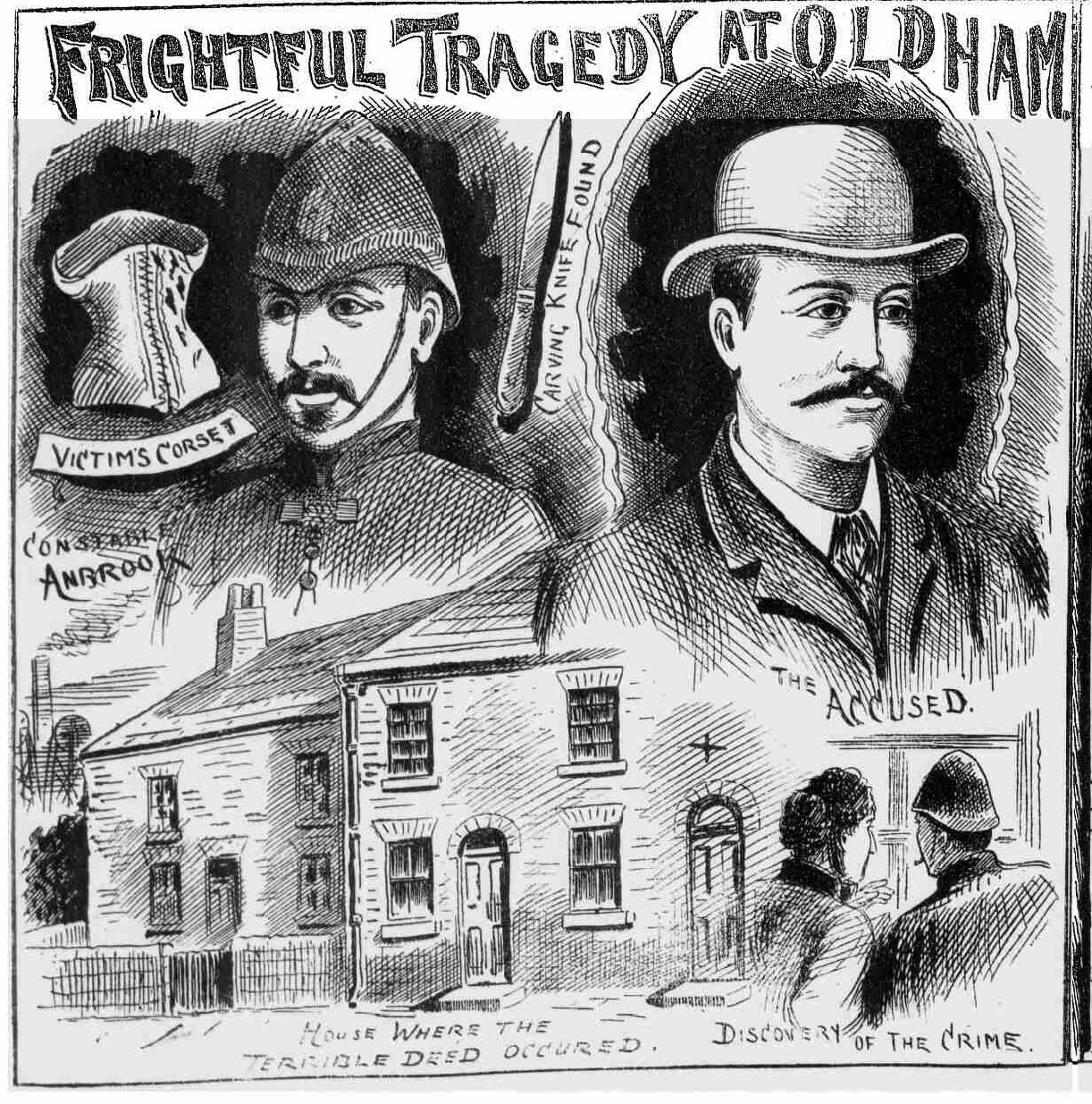
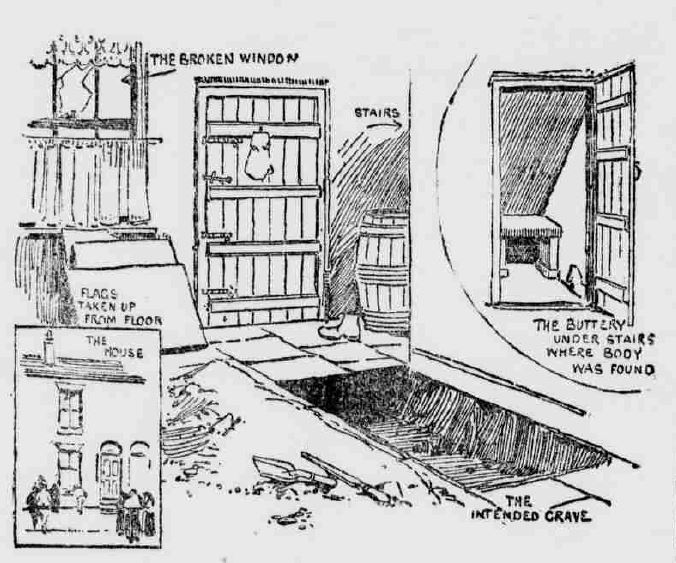
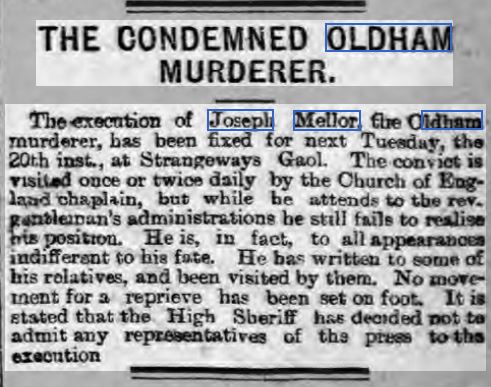
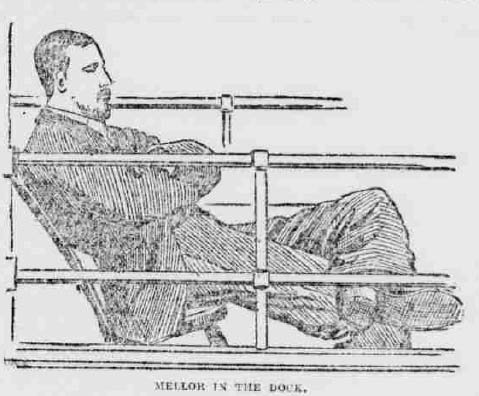
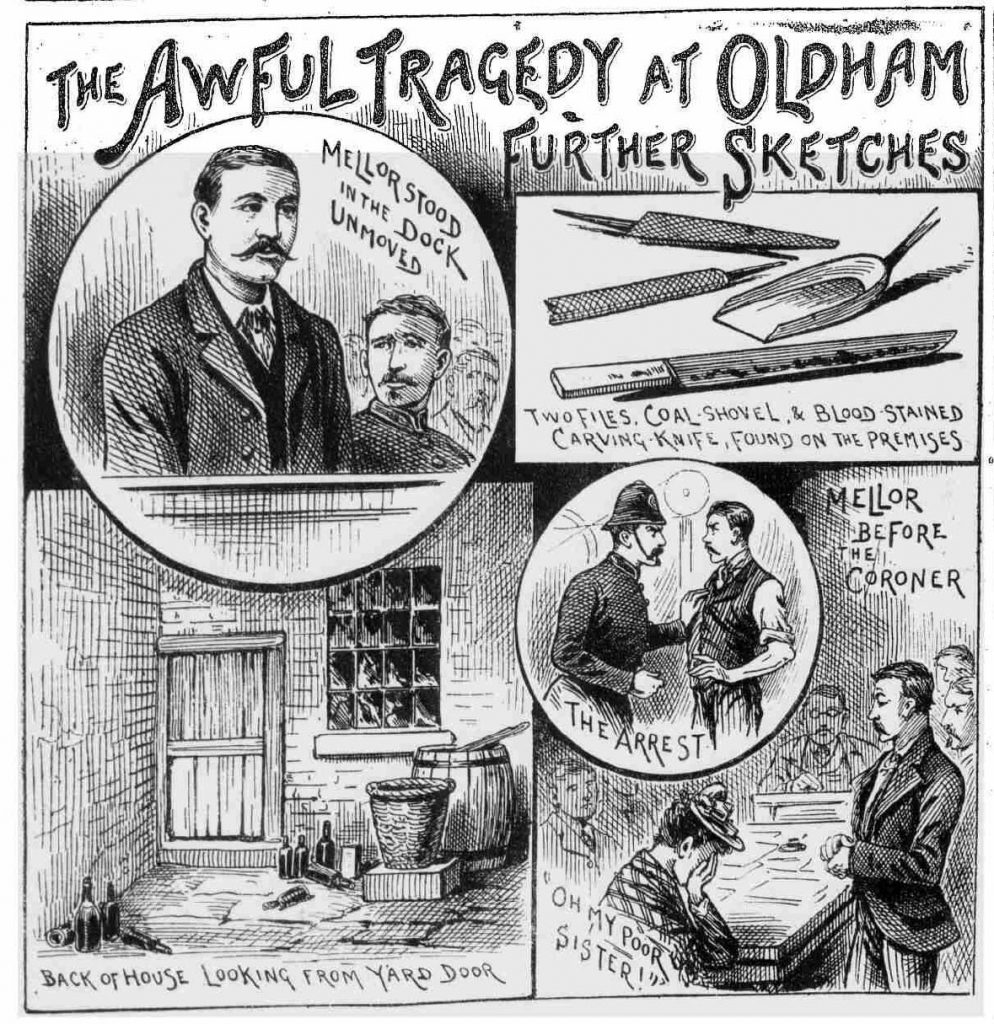
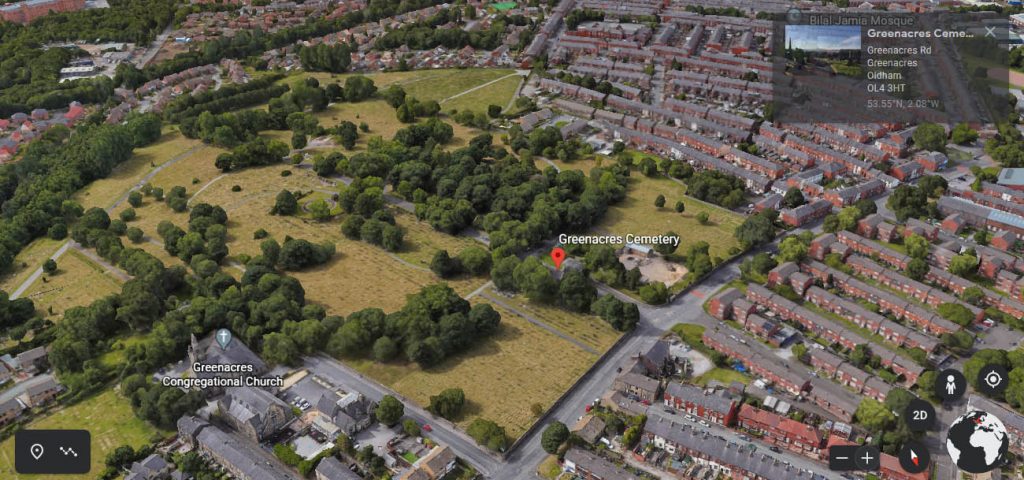
Leave a Reply